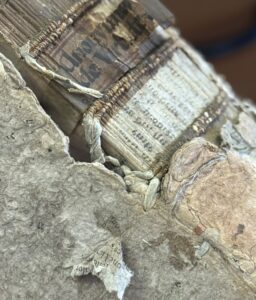 By Emma Laws, Cathedral Librarian
By Emma Laws, Cathedral Librarian
This book has seen better days. True, there are no queues at the West Wing door to see it today but its appearance suggests it was once rather more popular. The binding – what’s left of it – is contemporary with the text (early 17th century) but the leather covering is gone, revealing quite a complex structure underneath. The folded sections of text – called gatherings or quires – are sewn on tawed leather thongs, two at each sewing station. These thongs thread into the boards and provide a strong, flexible hinge so the covers can open and close easily. Strips of parchment from an old manuscript reinforce the spine.
Can you see the little piece of peeling upside-down printed text on the pasteboard cover? From the 16th century, binders made their own pasteboard covers by laminating – or pasting together – pieces of waste paper, including proof sheets and spoiled or misprinted sheets. Nothing was wasted! Pasteboard was much cheaper – and quicker to make – than wooden boards, and lighter in weight, too, so easily carried. Pasteboard could be covered in leather, parchment or cloth; without its outer covering, this board has partially delaminated, revealing tiny fragments of forgotten text.
Now encased in archival card and housed in an environmentally-controlled store, the book is stable; in fact, there’s no reason to believe it won’t last another four hundred years. A good thing, too, because it’s a printed edition (and Latin translation) of an original Greek manuscript that probably no longer exists. The editor, Johannes Wegelin (1568-1627), was a Protestant theologian and linguist with a keen interest in the intersection of ancient Greek philosophy and early Christian theology. His Anonymi Christiani philosophi liber de virtute, printed in 1604, preserves an influential early Christian text on the four cardinal virtues: prudence, justice, fortitude and temperance.